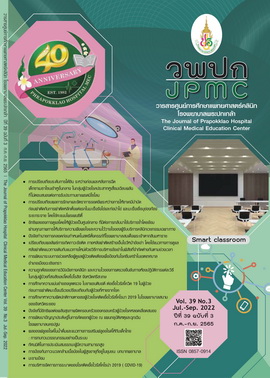Perspectives towards Talent Competencies Assessments
Main Article Content
Abstract
Finding and assessing the competencies of talented people appropriately could lead to enhancing the effectiveness of performance management and the improvement in management and workforce development, which is important for driving any organization and the country. Objectives of the research are 1) to analyze, synthesize, and identify the components and behaviors for 8 competencies for talented people, 2) to formulate the definitions, components and designated behaviors of 8 competencies and adopting criteria for competency assessments which are classified by management levels and talent measurement approaches, and 3) to propose recommendations for expanding related knowledge and innovations. The research method used in this study is the mixed-method approach which combines qualitative and quantitative data. Qualitative data was gathered from in-depth interviews of 9 key informants along with conducting a focus group discussion between multi-level of 11 executives; quantitative data was collected through survey questionnaires from 222 respondents. The main objective for collecting quantitative data is to conduct a confirmatory factor analysis (CFA) of 8 competencies under studied.
The commonplace and future competencies for executives at all levels are the same, which consist of 8-under studied competencies. Competency components and designated behaviors of talented people could appropriately be measured by talent assessment tools. There have been approaches which most organizations applied in assessing employee’s competencies and performance. For the result of CFA and weighted factor loading, it was found that the most important competency that indicates talented management level is leadership. For all that talented executives at all levels must have common competencies. However, the intensity of each competency will be varied in accordance with management levels, the expectations of stakeholders, and the type of organizations as well as the personal factors.
Article Details

This work is licensed under a Creative Commons Attribution-NonCommercial-NoDerivatives 4.0 International License.
References
Burns J, Movsisyan A, Stratil JM, Biallas RL, Coenen M, Emmert-Fees KMF, et al . International travel-related control measures to contain the COVID-19 pandemic: a rapid review. Cochrane Database of Systematic Reviews [ Internet] 2021 [cited 2022 Jan 17]. Available from: https://www.ncbi.nlm.nih.gov/pmc/articles/PMC8406796/pdf/CD013717.pdf
Hite LM, McDonald KS. Careers after COVID-19 : challenges and changes. Human Resource Development International 2020; 23:427-37.
Ekakul T. Research methodology in behavioral sciences and social sciences. Ubon Ratchathani: Ubon Ratchathani Rajabhat Institute; 2000.
Wongthongdee S. Human resource development. 3rd ed. Bangkok: Chulalongkorn University Press; 2016.
Wongthongdee S. Leaders, Managers, and HRD. Bangkok: Chulalongkorn University Press; 2018.
Suebvises P. Implementation of public and private organizations analysis and management in the 21st century. Bangkok: Graduate School of Public Administration National Institute of Development Administration; 2019.
Punyaratabandhu P.Leadership management development. Phitsanulok: Focus printing company limited; 2021.
Howattanakul S. The development of an education provision model to enhance professional competencies of graduates in the workforce shortage fields of study.Scholar: Human Sciences 2011;3(2):103-9.
Noe R, Hollenbeck JR,Gerhart B, Wright PM.Human resource management : gaining a competitive advantage.New York: McGraw-Hill/Irwin; 2021.

